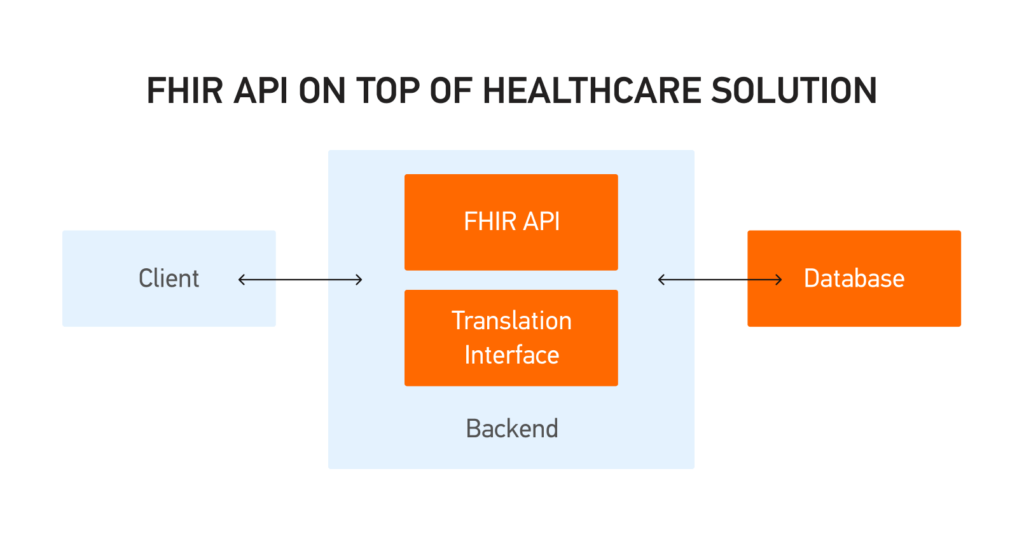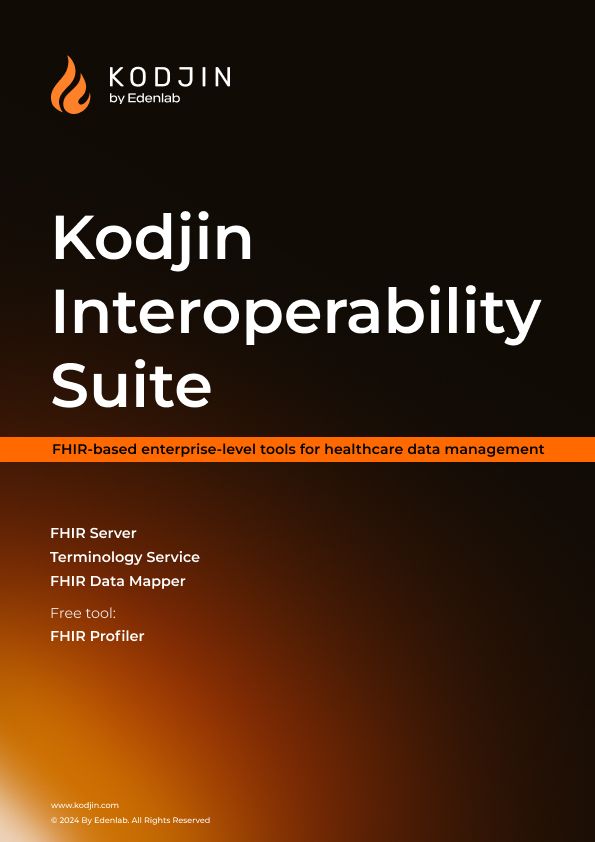Healthcare is a slowly developing industry in many ways. While the financial sector leveraged APIs and blockchain technologies long ago, healthcare still has much to catch up. Healthcare implies collecting, storing, protecting, and exchanging fragmented data.
Healthcare data management has been painful for many years due to the need for more standardization, forcing healthcare stakeholders to wonder what to expect in healthcare data management.
One of the most significant contributors to healthcare standardization has been the Health Level Seven (HL7) organization. In one of our previous articles, we talked more in detail about the organization, answered frequently asked questions about HL7 and FHIR, and discussed the most fundamental standards of HL7 (V2, V3, CDA, and FHIR).
The HL7 organization released the FHIR standard in 2014. But what is FHIR, and how does it impact healthcare data management? FHIR stands for Fast Healthcare Interoperability Resources and is a revolutionary standard that defines a set of rules for the electronic exchange of healthcare information and strongly affects the future of FHIR APIs. One of our previous articles will help you understand the FHIR components and resources. But the focus today is on FHIR API and the future of healthcare data management.
The Current Landscape of Healthcare Data Management
The Open Data Institute (ODI) and the World Health Organization (WHO) shed light on data management challenges. Data landscaping identifies stewards, data types, and relationships, highlighting value creation.
Data-driven healthcare ushers in personalized decision-making, empowering stakeholders and fostering innovation, equity, and collaboration. Diverse stakeholders engage with health data across local and global levels, with explicit and implicit applications shaping healthcare decisions.
Health data spans individual records, societal trends, and core datasets like civil registries, influencing healthcare insights. Navigating the data journey involves multiple stages, with cultural, trust, technical, privacy, security, and legal challenges.
Data stewards and processors collaborate for effective data sharing, grounded in robust governance, since ethical data utilization relies on thorough governance, building trust among stakeholders, and ensuring responsible data stewardship. Technology and legal frameworks bolster data security, privacy, and ethical practices.
In summary, the complex healthcare data landscape requires collaborative efforts, an understanding of data types, and robust governance. Trust and improved data sharing drive healthcare advancements as health data’s value grows.
WHAT FHIR API IS AND HOW IT AFFECTS HEALTHCARE DATA MANAGEMENT
What is API?
The Application Programming Interface (API) is a set of definitions and protocols for enabling applications to talk to each other. API allows for seamless communication between different systems. Moreover, API defines data exchange requirements, such as the format of exchanged data, its sequence, how to encrypt it, etc.
There are closed and open APIs, which are easy to figure out by the name: closed APIs are inaccessible for external use and can be used by the integral IT estate of an organization. An open API allows for data access to anyone who needs it.
Developers of IT solutions can use APIs to connect their new apps with any system and integrate the new application with the existing digital ecosystem.
What is FHIR API?
FHIR API, also known as the API for FHIR, is one of the main components of the FHIR standard and a game-changer in healthcare data management. FHIR is based on popular web technologies, namely HTTP, REST, JSON, and XML. It allows for the simple exchange and management of healthcare data regardless of the technologies used.
REST or Representational State Transfer is an architectural style that enables the communication between systems over the internet. RESTful APIs utilize HTTP protocol for software interactions and data exchange. HTTP supports CRUD methods (create, read, update, delete) to manipulate data. REST is the most popular technology for building APIs.
FHIR APIs support clinical workflows and provide caregivers with simplified real-time access to critical patient data, enabling more effective, personalized care. Thanks to modern web technologies, FHIR enables developers to create innovative healthcare IT solutions and ensures smooth and safe healthcare data exchange for better outcomes.
The Office of the National Coordinator for Health Information Technology (ONC) has realized the potency of API and its importance for effective healthcare data management. As a result, ONC has specified a requirement for EHR vendors to provide access to patient data via FHIR API in their Meaningful Use program.
What is the future of healthcare data management and FHIR APIs with ONC’s Meaningful Use program?
The ONC’s Meaningful Use program is essential in healthcare data management improvement. One of its main goals is to stimulate healthcare providers to use EHRs meaningfully and adopt modern technologies for improving the safety and efficiency of healthcare.
Another focus of the program is to encourage the adoption of interoperability standards, such as OMOP and FHIR standards, to enable the correct interpretation of healthcare data and smooth exchange between different systems and apps. These regulations contribute to building a healthy environment in the healthcare industry by promoting effective collaboration between healthcare providers and ensuring patient-centered care.
The third stage of the Meaningful Use program (MU3) is critical in the context of API integration. The MU3 requirements include the implementation of open APIs and open standards. The requirements in the MU3 program are intended to improve healthcare data management and provide patients with access to their health data.
Read Also: Why Choose an Event-Driven FHIR Architecture
HOW DATA MANAGEMENT CAN BE USED IN HEALTHCARE IN THE FUTURE
It is not only healthcare data regulations that impact the future of FHIR APIs and healthcare data management but also a healthtech revolution. FHIR APIs help promote the IoMT in healthcare since it facilitates healthcare data exchange between new healthcare applications and wearables.
Read also: TEFCA in Healthcare
During our recent webinar on data quality in healthcare, we received several questions about APIs, which is unsurprising since it has the potential to revolutionize data quality in healthcare. Exchanging data in a standardized way can improve the consistency and accuracy of healthcare data and minimize errors and duplicates.
The development of the healthcare industry has yet to reach its peak. The industry has faced many data management issues, such as processing complex data, which is why FHIR API is crucial. It ensures data accuracy during the exchange process.
The general adoption of FHIR API will help overcome data management issues and finally determine what is the future of data management in healthcare.
HOW TO USE FHIR API IN THE FUTURE
Due to the mandated use of FHIR APIs in the U.S. and its numerous advantages, we can recommend the following API strategies: use FHIR server API or FHIR facade.
- FHIR Server API
A FHIR server can significantly simplify healthcare data management by providing a secure and scalable platform for the management of healthcare data (such as patient records, laboratory test results, medical images, etc.). A FHIR server is an out-of-the-box data storage and exchange solution.

A FHIR API allows for quick and straightforward server integration into any application, so developers can ensure a standardized way of accessing healthcare information. It is better to choose a FHIR server with proven scalability. Servers tested by working with large volumes of data can be easily scaled up or down to meet the specific need of any healthcare organization and adapt server functionality to its specific data management needs.
One of the primary healthcare data management concerns is protecting sensitive patient data. Thus, a server should include robust security features, for example, data encryption, data anonymization, role-based access control, logging and monitoring, etc. These measures ensure the security of patients’ data while exchanging it between different systems and healthtech solutions.
The Kodjin FHIR server is a smart-storage tool that enables maximum usage of FHIR capabilities. The server allows storing all kinds of healthcare data and accesses it through the FHIR RESTful API. Moreover, the server provides advanced data management functionality, including the FHIRPath, FHIR subscription, FHIR profile validation, and support for all FHIR versions.
FHIR APIs in the future will reduce the efforts required to exchange data and switch the focus of healthcare providers from data management issues to healthcare services. Adopting FHIR server API is an excellent way to ensure safe and standardized healthcare data exchange.
FHIR facade is a powerful healthcare analytics tool that enables standardized exchange and management of healthcare data. FHIR facade provides a vendor-neutral layer that performs perfectly to update a legacy system and ensure compliance with healthcare data standards. FHIR facade is a cost-effective solution for improving outdated systems and enhancing data management efficiency.
In addition to a server, the FHIR facade provides a standardized API, so a system that interacts with an API considers a FHIR facade to be a FHIR server. However, the facade only imitates the server and supports the proprietary workflow of the system it communicates with.

The facade provides a secure gateway for exchanging sensitive healthcare data. A FHIR facade is software with flexible functionality any healthcare provider can tailor to the specific needs of an organization. Therefore, it can improve the security and privacy of healthcare data and help a healthcare provider meet the national healthcare data management requirements.
Collaborative Approaches and Industry Trends
The FHIR community has played a pivotal role in advancing standard development within the healthcare industry, driving its rapid evolution. Recognizing the significance of this collaborative effort, HL7 has introduced the HL7 FHIR ACCELERATOR program, which helps with popularizing FHIR API by facilitating the creation and adoption of robust FHIR Implementation Guides, ultimately leading to seamless global health data interoperability.
FHIR community representatives (some of HL7 FHIR Accelerators)
- The Argonaut Project, launched in 2014 as a private-sector initiative, aimed to revolutionize health data exchange using internet technologies and played a significant role in shaping the development of the US Core Implementation Guide, offering a framework embraced by healthcare stakeholders across the spectrum.
- The CARIN Alliance unites consumers, payers, health IT firms, advocates, certifiers, identity providers, and U.S. organizations, collaborating with the government to create Implementation Guides that empower consumers and caregivers to access and share digital health data in alignment with their goals.
- CodeX, or Common Oncology Data Elements Extensions, is committed to enhancing cancer care and research by collaboratively testing and integrating the mCODE (minimal Common Oncology Data Elements) FHIR Implementation Guide. This effort facilitates seamless cancer data exchange and results in crucial mCODE-based FHIR implementation guides covering various aspects of oncology, from cancer registry reporting to radiation therapy treatment data.
- Da Vinci Project pioneers the adoption of FHIR standards in healthcare by creating standardized mechanisms. It ensures smooth data exchange among stakeholders, emphasizing the transition to value-based care while gaining recognition from the ONC, which designates HL7 FHIR v4.0.1 as a healthcare API standard.
The healthcare industry continues to evolve through collaborative initiatives and innovative technologies. At the same time, the FHIR community and accelerators are shaping the healthcare data management landscape and interoperability.
KODJIN WILL HELP YOU DEVELOP A ROBUST HEALTHCARE API STRATEGY
Now that you know how FHIR is impacting the future of healthtech, you should consider using FHIR APIs in the future. Our FHIR experts have built an enterprise-level Kodjin FHIR server from scratch. Thoughtful expertise of industry needs has allowed our team to make the server for high-load projects with a low-code declarative approach.
The Kodjin team will help you integrate your system with a FHIR facade and upgrade it so that it can manage healthcare data just like a system with a FHIR backend. For upgrading legacy systems, we can definitely develop the best strategy. Acting as a secure and scalable healthcare analytics platform, Kodjin empowers healthcare providers to store, process, and analyze complex medical data while ensuring full interoperability and compliance with global standards.
For example, one of our projects was the Ukrainian national healthcare system development. The project’s baselines included the legacy system, outdated clinical registries, low-level computer literacy among Ukrainian GPs, and other challenges.
Our team used HL7 FHIR for data storage, data warehouse and data mining, and developed an open API to connect all Medical Information Systems, which resulted in a modern and secure repository for over 35M patient records.
Still wondering what FHIR is and how to use this standard to the best advantage for your project? Contact us to get professional assistance with FHIR software development and SMART on FHIR service.
FAQ
- How do FHIR APIs enhance patient-centric care?
FHIR APIs enable more effective and personalized patient-centric care by providing caregivers with simplified real-time access to critical patient data, utilizing user-friendly web technologies like HTTP, REST, JSON, and XML.
- How do IoT devices and wearables impact healthcare data management?
IoT devices and wearables impact healthcare data management by enabling real-time data exchange with healthcare applications and improving data consistency.
- How can healthcare organizations ensure data security and privacy in the future?
Healthcare organizations can ensure future data security and privacy through modern technologies, robust security measures, and compliance with healthcare data management requirements.







